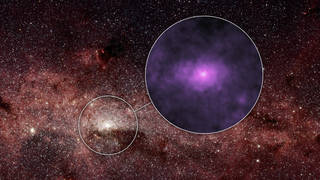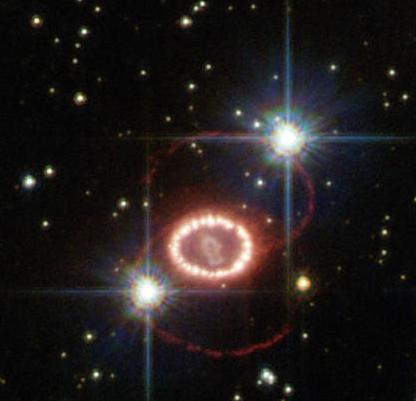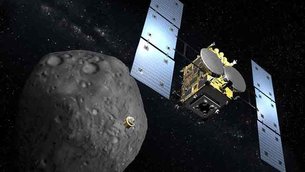

May 2015
Black Holes Dining at High Rates
NASA's Chandra X-ray Observatory has be looking at a group of distant quasars located about 5 billion and 11.5 billion light-years away. Their observations indicate that the black holes associated with these quasars are feeding at an exceptionally high rate. This could lead to a better understanding of how the largest black holes were able to grow so rapidly in the early Universe.
As gas and dust are pulled into a supermassive black hole, the matter being pulled in begins to glow and shoot off radiation. This is a quasar. Quasars are usually found in black holes at centers of far off distant galaxies. Since it took the light several billion years to get here, we are seeing the quasars as they were in the past during the formation of the early Universe. After a time, quasars diminish and disappear when the black hole has pulled in all of the surrounding dust and gas. So to examine quasars and supermassive black holes, we need to look far out into the Universe.
Chandra surveyed 51 quasars that had unusually weak emissions from certain elements like carbon in the ultraviolet wavelengths. Chandra measures X-rays, and found in these quasars that the X-rays were about 40 times weaker than normal on average than in typical quasars.
Computer models predict that if the black hole is pulling in matter at a low rate, the matter swirls around forming a disk around the black hole. If the black hole is pulling in matter at a very high rate, the radiation and pressure builds up to form a 'donut' around the inner part of the disk. This area of pressure prevents the radiation from moving outward to strike the outer gases. Thus we see less emissions from the quasar in the ultraviolet and X-ray wavelengths.
This new data is helping scientists understand the formation of the Universe. It indicates that black holes were very active and existed in the very early stages of the Universe.
Zombie Stars
A mysterious glow of high-energy X-rays has been detected by NASA's Nuclear Spectroscopic Telescope Array (NuSTAR). Found near the center of the Milky Way, these X-rays may be dead stars feeding on stellar companions.
At the center of the Milky Way are a variety of objects including new and old stars along with the remains of dead stars. They all move around a supermassive black hole called Sagittarius A.
NuSTAR has recently found a region of high-energy X-rays about 40 light-years across near the black hole. This finding has puzzled scientists. Theories are being put forth to explain the observations. Several of the theories involve dead, or "zombie" stars.
When a star dies, depending on its original mass, the star will either become a white dwarf (like our sun will), or it will become a neutron star forming a pulsar, or it will become a black hole if it is massive enough. In all cases, if the star was part of a star system, a binary system for example, the dead star would have enough gravity to start 'feeding' on its companion star.
What NuSTAR is seeing could be a group of pulsars. If this is the case, these pulsars have never been seen before and could mean something is going on in the environment around the black hole at the center of our galaxy we do not yet know about.
Another theory does not involve dead stars but cosmic rays. When matter is pulled into a black hole, cosmic rays are produced. These cosmic rays then interact with the surrounding gases and emit X-rays.
The center of the galaxy is a constantly changing and chaotic place. New incredible finds create new theories and new pieces to the puzzle of how galaxies, including our own Milky Way formed and evolved.

The high-energy X-ray emission discovered by NuSTAR at the center of our Milky Way.
Credit: NASA/JPL-CalTech
Lopsided Star Explosion
Scientists have surmised that a Type-II supernova explosion is usually asymmetrical, meaning move matter is shot out in one direction than evenly around the star. But until now, they have not had the first hand proof. NASA's NuSTAR (Nuclear Spectroscopic Telescope Array) has been looking at a supernova, called 1987A, and has now found the evidence for an asymmetrical, or lopsided, explosion.
Supernova 1987A was seen on Earth in 1987. It originated when a star exploded 166,000 light-years away. With today's telescopes and technology, this is one of the first supernova we are able to observe and study closeup as the explosion unfolds.
NuSTAR looked at the radioisotope titanium-44 and mapped it over the course of the explosion. Titanium is produced in the heart of the explosion. NuSTAR data shows the material is moving away from us and not evenly distributed around the exploding star. The titanium-44 is moving at a velocity of 1.6 million miles per hour (2.6 million kilometers per hour). While the titanium-44 is moving in one direction, the core of the star moves in the opposite. In this case the exploded star formed a neutron star.
NuSTAR observed a similar activity on another supernova, Cassiopeia A, but not to the extent found on 1987-A. As titanium-44 is only produced in the explosion, it is an ideal element to use to map a star's explosion.
These finding lead scientists to believe that just before a star explodes the core becomes turbulent, boiling and begins to slosh around. At that point the star explodes and sloshing causes the explosion to be asymmetrical and blow out one side of the star.

Supernova 1987A. The bright ring is material ejected before the star exploded. Credit: ESA/Hubble & NASA
Upcoming Launches
Date: May 26
Launch Vehicle: Soyuz
Launch Site: Baikonur Cosmodrome, Kazakhstan
Description: Kjell Lindgren of NASA, Kimiya Yui of JAXA and Oleg Kononenko of Roscosmos launch to the International Space Station
Galaxies Die Inside Out
ESO's Very Large Telescope (VLT) in Chile, along with the Hubble Space Telescope, has revealed that star formation in galaxies quit at the center of the galaxy first. The telescopes studied galaxies that are considered "dead", meaning they have little or no star formation going on. These galaxies quit making stars billions of years ago.
The galaxies are massive elliptical galaxies that are common in the Universe. These galaxies are densely packed with ten times more stars at the their center regions than the Milky Way. In the early Universe, not long after the Big Bang, these galaxies made stars at high rates. But about three billion years after the Big Bang, star production stopped in the central regions. Star formation was only going on in the outer regions of the galaxy before that also ceased, leaving a galaxy with only old stars.
The Spectrograph for INtegral Field Observations in the Near Infrared (SINFONI), an instrument on the VLT, collected light from 22 galaxies about 10 billion light-years away. SINFONI was able to show precisely where new star formation in these galaxies was taking place. Hubble was able to show where the old stars were located.
There are many theories on why this happens. One theory of what is going on is that the central black hole of the galaxy has so much matter to feed on that the high amounts of energy released by the pulled in matter sends out torrents of star making materials. As the black hole consumes all around it, the star making matter quits being sent out. This would start at the center of the Universe since that is where the black hole is located.
First Reflected Light from Exoplanet
Astronomers have, for the first time, recorded the reflected light off an exoplanet. Up until now, exoplanets could only be measured and "seen" as they passed in front of the their star. But now, using the High Accuracy Radial velocity Planet Searcher (HARPS) at ESO's La Silla Observatory in Chile, astronomers were able to look directly at the planet.
The exoplanet 51 Pegasi b is 50 light-years from Earth in the constellation Pegasus. Discovered in 1995, 51 Pegasi b was the first planet ever found orbiting a star about the same size as our sun. The planet itself is about the size of Jupiter but is much closer to the star than Jupiter is to our sun. Planets like this are now found to be commonplace and we call them "hot-Jupiters".
By looking at the light reflected from the planet, astronomers can learn about the planets makeup including its atmosphere and surface. HARPS data shows that 51 Pegasi b has a mass of about half of that of Jupiter and has an inclination of about nine degrees to the direction to the Earth. Even though the mass is half of Jupiter's, the planet is larger in size than Jupiter and is highly reflective.
This technique can now be used on other exoplanets. The data is tantalizing, telling us a little more about the exoplanet. Astronomers now eagerly await ESPRESSO on the VLT. ESPRESSO is the Echelle SPectrograph for Rocky Exoplanet and Stable Spectroscopic Observations instrument. It will be able to search for rocky planets like the Earth and study their physical makeup and chemical compositions. ESPRESSO is scheduled to make its first readings in 2016.
Asteroid Sample Return Mission
After a launch last December, Japan's Hayabusa-2 spacecraft is on a six year mission to return a sample of an asteroid. Hayabusa-2 is headed toward the asteroid 1999 JU3 and is set to arrive in June 2018. Upon arrival the spacecraft will study the asteroid that is known to be carbon-rich.
Hayabusa-2 carries several drones that will be dispatched to the surface of the asteroid. In addition to the 3 landing drones, the spacecraft also carries the Mascot lander. Developed by the DLR German Aerospace Center in cooperation with France's CNES space agency, the lander is equipped with a 'hopper' mechanism to enable it to jump from location to location on the asteroid.
As a climax to the mission, Hayabuse-2 will fire off explosives into the asteroid and then scoop up the fragments that fly off the surface in a daring touch and go maneuver. The fragments will be returned to Earth in 2020.

Artist concept. Credit: JAXA
© 2014-2016 Ted Cook Productions LLC. - All Rights Reserved

